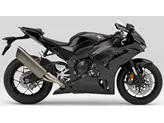Kawasaki Ninja ZX-10R 2016 vs. Yamaha R1 2016

Kawasaki Ninja ZX-10R 2016

Yamaha R1 2016
Overview - Kawasaki Ninja ZX-10R 2016 vs Yamaha R1 2016
The Kawasaki Ninja ZX-10R and the Yamaha R1, both released in 2016, are two high-performance supersport motorcycles that offer impressive specifications and features. While they share many similarities, there are also notable differences between the two.
In terms of engine and drive train, both motorcycles have a 998cc engine with four cylinders. The Kawasaki Ninja ZX-10R has a bore of 76 mm and a stroke of 55 mm, while the Yamaha R1 has a slightly larger bore of 79 mm and a shorter stroke of 50.9 mm. Both bikes have a compression ratio of 13 and produce similar power, with the Kawasaki Ninja ZX-10R delivering 200.1 HP and the Yamaha R1 producing 200 HP. The torque output is also similar, with the Kawasaki Ninja ZX-10R generating 114.3 Nm and the Yamaha R1 producing 112.4 Nm.
In terms of suspension, both motorcycles feature upside-down telescopic forks in the front. The chassis of both bikes is made of aluminum, providing strength and stability. The front brakes on both motorcycles are double disk type, ensuring excellent stopping power.

Kawasaki Ninja ZX-10R 2016
When it comes to dimensions and weights, both motorcycles have a front tire width of 120 mm and a front tire diameter of 17 inches. The rear tire width is also the same at 190 mm, with a diameter of 17 inches. The wheelbase of the Kawasaki Ninja ZX-10R is slightly longer at 1415 mm compared to the Yamaha R1's 1405 mm. The seat height of the Kawasaki Ninja ZX-10R is 813 mm, while the Yamaha R1 has a higher seat height of 855 mm. Both motorcycles have a fuel tank capacity of 17 liters.
Now, let's discuss the strengths and weaknesses of each motorcycle. The Kawasaki Ninja ZX-10R stands out for its great chassis geometry, which contributes to its excellent handling and stability. It also boasts high-quality chassis components, ensuring a smooth and comfortable ride. The brakes on the Kawasaki Ninja ZX-10R are very good, providing strong and reliable stopping power. Additionally, the motorcycle comes with a comprehensive electronics package, offering various features and aids for enhanced performance and safety.

Yamaha R1 2016
On the other hand, the Yamaha R1 is praised for its lively handling, making it a fun and engaging motorcycle to ride. The engine of the Yamaha R1 is high-revving and precisely controllable, allowing riders to push the bike to its limits with confidence. The electronics package on the Yamaha R1 is also excellent, providing advanced features and assistance for optimal performance.
However, the Kawasaki Ninja ZX-10R has a weakness in its cockpit, which is not quite optimal for readability. On the other hand, the Yamaha R1's weakness is that its shift assistant is only available for upshifting.
In conclusion, both the Kawasaki Ninja ZX-10R and the Yamaha R1 are impressive supersport motorcycles that offer high-performance capabilities. While the Kawasaki Ninja ZX-10R excels in chassis geometry, high-quality components, and a comprehensive electronics package, the Yamaha R1 stands out for its lively handling, precise engine, and excellent electronics package. Riders should consider their preferences and priorities to choose the motorcycle that best suits their needs.
Technical Specifications Kawasaki Ninja ZX-10R 2016 compared to Yamaha R1 2016
Pros and Cons in comparison
Pros and Cons in comparison
Kawasaki Ninja ZX-10R 2016

The ZX-10R Ninja has a certain majesty, at the first rollout it seems very stable, you have to force it into the radius a little. After a few laps, however, this effect is transformed into an incredible precision that allows a pinpoint line. The engine has now really become noticeably stronger and makes the Kawa an enormously good overall package that can please not only die-hard Kawasaki fans. The traction control on the Kawa is particularly positive and regulates very sensitively. You can even adjust the engine brake - so it certainly doesn't lack for electronic features. The ZX-10R is the only superbike that is already Euro4-compliant in 2016!
Yamaha R1 2016

Yamaha's high-tech rocket is still a technological leader in 2016. Radical, polarising and fascinating, it sets powerful lap times. It is closer to the race bikes than the other 1000s. In the meantime, no one grumbles about the front. Without the "M", it is the best choice for those who don't need Öhlins anyway, or the best choice for those who are planning a racetrack conversion anyway and like to install "normal" Öhlins hardware without electric stuff.
Price Comparison Avarage Market Price Kawasaki Ninja ZX-10R vs Yamaha R1
There are a few key differences between a Kawasaki Ninja ZX-10R 2016 and a Yamaha R1 2016. In terms of price, the actual average price of a Kawasaki Ninja ZX-10R 2016 is about 27% higher. A Kawasaki Ninja ZX-10R 2016 experiences a loss of 1,650 USD in one year and 1,600 USD in two years of ownership. This is offset by a loss of 670 USD and 590 USD for a Yamaha R1 2016. Compared to Yamaha R1 2016 there are less Kawasaki Ninja ZX-10R 2016 bikes available on the 1000PS.de Marketplace, specifically 4 compared to 6. It takes less time to sell a Yamaha R1 with 73 days compared to 100 days for the Kawasaki Ninja ZX-10R. Since model year 2005 1000PS.de editors have written 51 reviews for the Kawasaki Ninja ZX-10R and 80 reviews for the Yamaha R1 since model year 2005. The first review for the Kawasaki Ninja ZX-10R was published on 1/11/2004 and now has more than 2,900 views. This compares to more than 3,900 views for the first review on Yamaha R1 published on 4/28/2003.






















